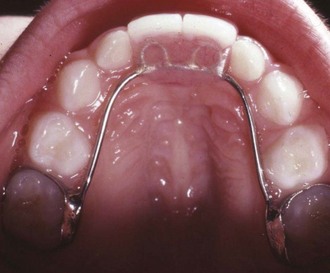Space Maintenance in the Primary Dentition
General Considerations
Management of premature tooth loss in the primary dentition requires careful thought by the clinician, because the consequences of proper or improper space maintenance may influence dental development well into adolescence.1 Early loss of primary teeth may compromise the eruption of succedaneous teeth if there is a reduction in the arch length. On the other hand, timely intervention may save space for the eruption of the permanent dentition. The key to space maintenance in the primary dentition is in knowing which problems to treat.2
Premature tooth loss in this age group is best thought of in terms of anterior (incisors and canines) and posterior (molars) teeth. The causes and treatment of missing teeth differ in these two regions. Anterior tooth loss is due primarily to trauma and tooth decay. Injuries to the primary incisors are common because a child of this age is learning to walk. Although the prevalence of dental decay appears to be declining, a small number of children still suffer from early childhood caries and rampant decay and experience most of the dental disease.3 These decay patterns result in tooth loss in both the anterior and posterior regions. The majority of posterior tooth loss is due to dental caries; rarely are primary molars lost to trauma. If no space loss has occurred immediately after tooth loss, space maintenance is appropriate because the permanent successor will not erupt for several years. If space loss has occurred, a comprehensive evaluation is required to determine whether space regaining or no treatment is indicated. This type of evaluation and decision-making is described in the discussions of the mixed dentition (Chapters 30 and 35) because most attempts at regaining space are made at that time.
Some investigators have cited slowed or altered speech development as a justification for replacing missing maxillary incisors. This may be valid if the child has lost a number of teeth very early and is just beginning to develop speech. Many sounds are made with the tongue touching the lingual side of the maxillary incisors, and inappropriate speech compensations may develop if these teeth are missing. However, if the child has already acquired speech skills, the loss of an incisor is not particularly important.4
Probably the most valid reason for replacing missing incisors is aesthetics. Aesthetic concerns are voiced by some parents but not by others. If parents do not indicate a desire to replace missing anterior teeth, certainly no treatment is appropriate. If the parents do wish to replace the missing teeth, either a fixed lingual arch or a removable partial denture with attached primary teeth can serve as a prosthetic replacement (Figure 25-1). The dentist should present both alternatives and let the parents make an educated decision.
Therefore space maintenance during the primary dentition years is aimed primarily at the replacement of primary molars. Loss of interproximal contact as a result of decay, extraction, or ankylosis of an adjacent tooth results in space loss because of mesial and occlusal drift of the tooth distal to the newly created space. There is also evidence that the tooth mesial to the affected molar will drift distally into the space.5,6 Thus loss of space or arch length can occur from both directions (Figure 25-2).
Stay updated, free dental videos. Join our Telegram channel

VIDEdental - Online dental courses


 Outline
Outline
 FIGURE 25-1
FIGURE 25-1
 FIGURE 25-2
FIGURE 25-2